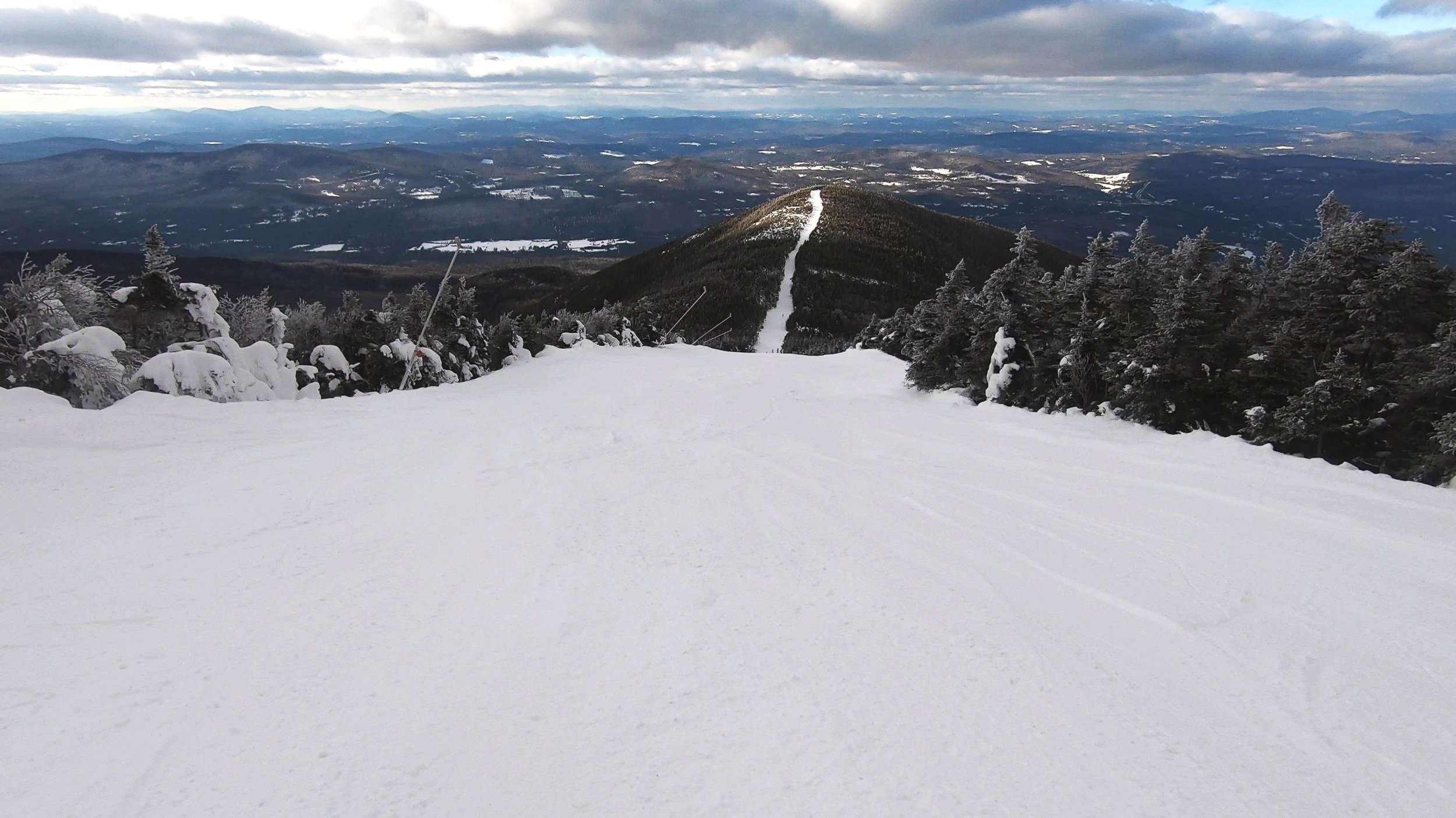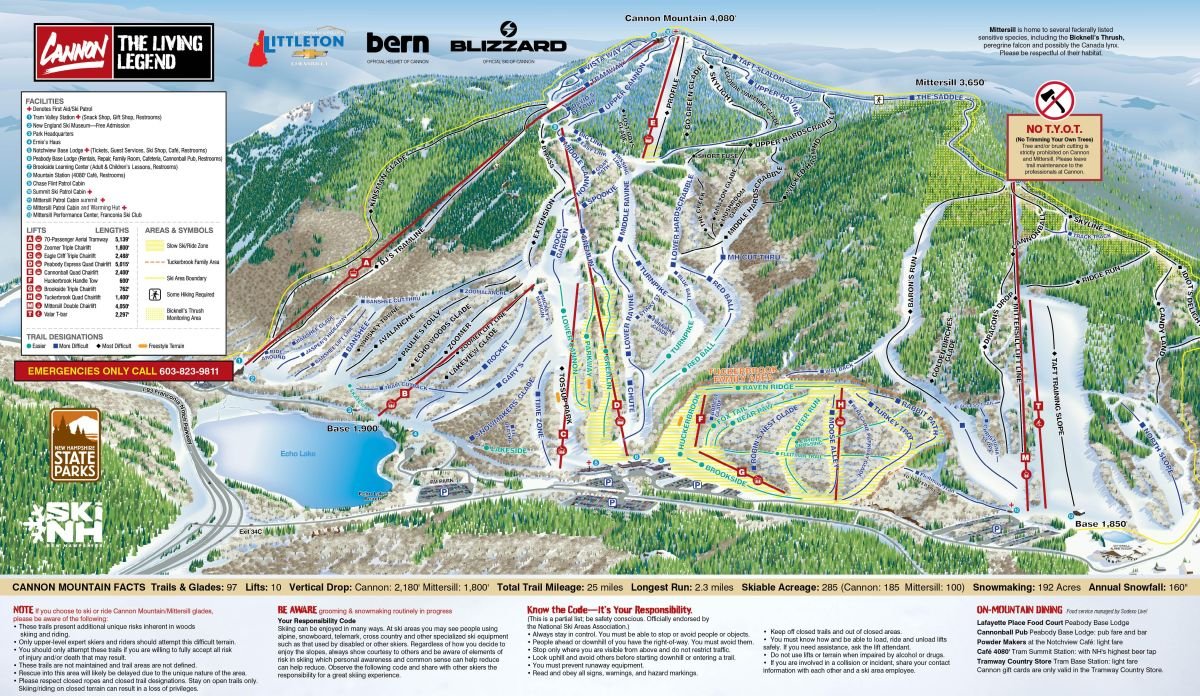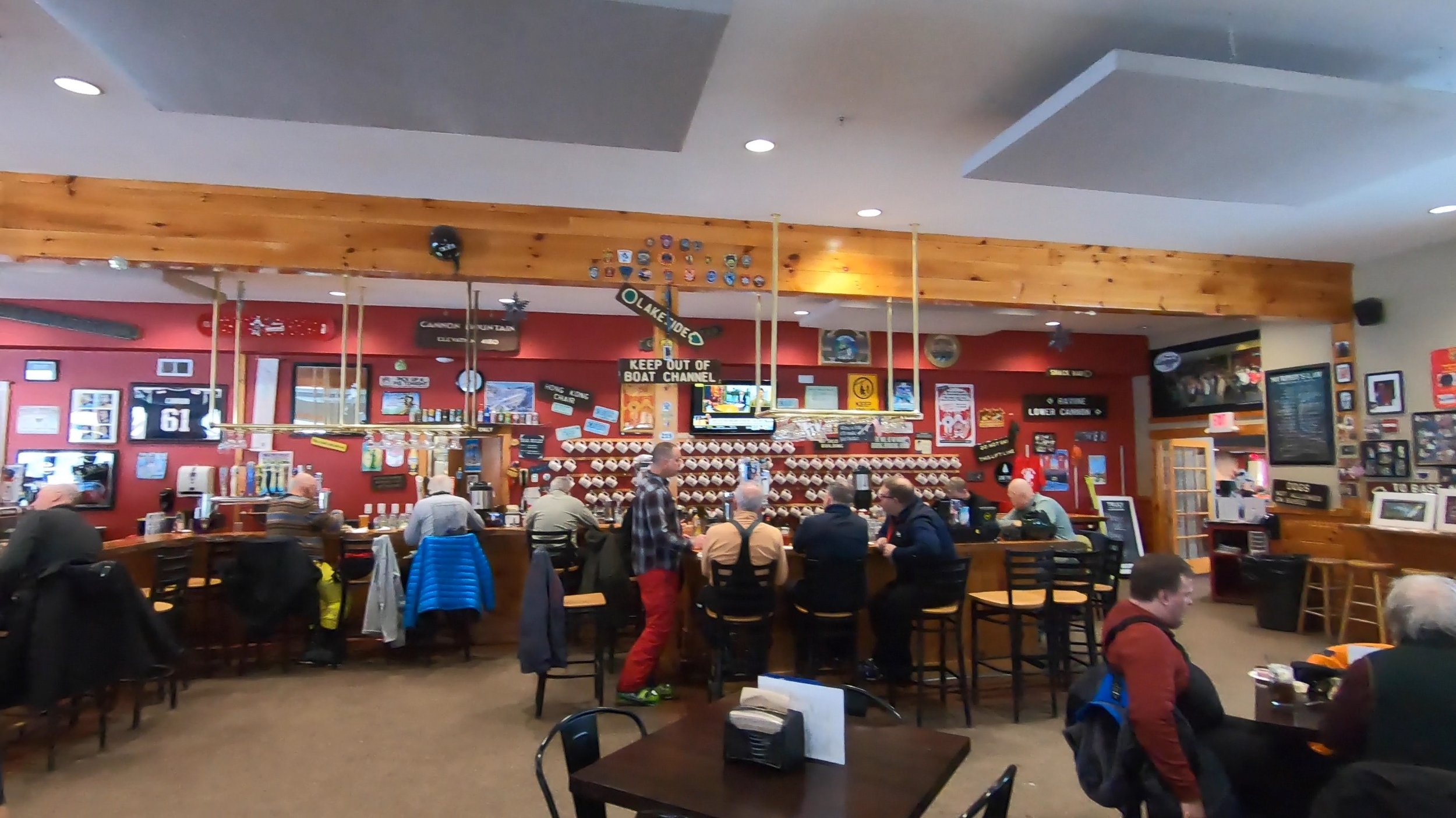Mountain Review: Cannon
MOUNTAIN SCORE
CATEGORY BREAKDOWN
See our criteria5
Snow:
3
Resiliency:
3
Size:
5
Terrain Diversity:
8
Challenge:
4
Lifts:
8
Crowd Flow:
4
Facilities:
6
Navigation:
7
Mountain Aesthetic:
GOOD TO KNOW
1-Day Ticket: $96-$111
Pass Affiliation: Indy Pass
On-site Lodging: Limited
Aprés-ski: Limited
Nearest Cities: Boston (2 hrs), Montreal (3 hrs)
Recommended Ability Level:
+ Pros
Local feel
Modest crowds
Striking surrounding scenery
Extremely demanding expert runs
– Cons
Profound wind exposure
Inconsistent expert terrain openings
Limited beginner terrain
Slow lifts in some areas
Very limited on-site lodging
MOUNTAIN STATS
Lifts: 10
Trails: 97
Beginner: 15%
Intermediate: 52%
Advanced/Expert: 33%
Mountain Review
Looking for an authentic, character-laden ski resort within close proximity to Boston? New Hampshire’s Cannon Mountain comes across as a compelling proposition. With a location within Franconia Notch State Park, a nearly 2,200-foot vertical drop, and New Hampshire’s only aerial tramway, there’s a lot to like about Cannon on paper. However, a few logistical circumstances make for some major drawbacks if you book a vacation here at the wrong time.
Size and Terrain Layout
Spanning 285 skiable acres and 97 named trails, Cannon is one of the larger New Hampshire ski resorts, although it’s still quite a bit smaller than New England’s biggest mountains. But despite its moderate size, Cannon offers a distinct, varied footprint, with a wide range of trails and glades throughout. The resort spans two distinct mountain areas: Cannon Mountain itself, which hosts the majority of terrain, and Mittersill, which primarily serves as a race training venue and caters much more to advanced-level guests.
Cannon’s 285-acre footprint makes it one of New Hampshire’s larger ski resorts.
Beginner Terrain
Cannon’s terrain offerings may be diverse, but the resort is not ideal for beginners. Only a handful of lower-mountain areas serve green terrain, and while the beginner-oriented Tuckerbrook zone does offer an isolated pod designed for less experienced guests, its learning area is behind the times, with a rope tow for the bunny hill rather than a magic carpet. Often-hard-packed snow conditions also make for less enjoyable slopes than those of competitors. Ultimately, beginners will find much better ski areas elsewhere in the state.
While beginner terrain is very limited, Cannon offers a range of distinct intermediate trails.
Intermediate Terrain
Cannon becomes much more competitive for intermediate-level guests. On Cannon Mountain itself, visitors will find an extensive variety of moderately-sloped groomers, with options ranging from straight shots down the mountain to windy cruisers. Cannon’s upper-mountain blues especially stand out for their imposing views of nearby Franconia Notch mountains.
The Mittersill side is less inviting for intermediates, with no intermediate runs available from the top of the primary double chairlift. However, several of the Mittersill side’s black runs are groomed, and there are a few short blues off the lower half of the t-bar.
TRAIL MAP
Advanced and Expert Terrain
What you’ll really want to be when you visit Cannon is an advanced or expert skier or rider. The resort hosts some of the best steeps east of the Mississippi, ranging from narrow, mogully trails to demanding glade zones.
Must-hits for experts include DJ’s Tramline, which starts out as a narrow glade trail before emptying out into a steep, notoriously long fall line with several sections of bare rock, Kinsman Glade, which sits immediately to skiers’ right of Tramline but offers the same daunting slope length in woods format, and the black runs off the Zoomer lift, which are short but mogully and perfect for quick leg burners. If you know where to look, the resort even features a number of unmarked trails that involve mandatory cliffs.
It’s worth noting that Cannon’s difficulty rating tops out at the single-black diamond, and the trails with this designation vary widely in challenge; as a result, even though the resort offers what might be the toughest in-bounds footprint in New Hampshire, several black runs—most notably on Mittersill—are perennially groomed, and not much tougher than Cannon’s blues.
Cannon offers some of the gnarliest ski resort terrain in the state of New Hampshire, but it’s often closed due to variable conditions.
Variable Terrain Openings
Cannon’s expert runs—and certain other resort areas—are subject to highly variable openings throughout the winter. Cannon bears one of the most highly exposed footprints in the region, and icy, windswept conditions are common. In addition, while its snow totals aren’t bad, the resort often just doesn’t see enough accumulation to fill in its hairiest terrain—or, in the event that a wind storm or freeze-thaw cycle has passed through, recover fast enough to keep this terrain reliably open.
Cannon does employ enough snowmaking to keep most of its beginner and intermediate terrain resilient through less-than-ideal snow conditions, but on bad days, more than half the advanced and expert trails may end up closed. To get the most out of Cannon, you really need to go on a powder day.
Cannon features the only aerial tramway in the state of New Hampshire.
Aerial Tram
Cannon offers one of the most unique uphill lift setups in New England thanks to its aerial tramway. This 70-passenger lift spans the entire vertical drop of the resort, and allows guests to lap the easternmost part of the resort through a single lift. In addition, riding up the enclosed tram provides isolation from the elements on particularly cold and windy days, making it much more comfortable than other chairlifts on the mountain.
RECOMMENDED SKIS FOR CANNON
NOTE: We may receive a small affiliate commission if you click on the below links. All products listed below are unisex.
Recommended all-mountain ski
Recommended carving ski
Recommended glade ski
Recommended expert/touring ski
Other Lifts
But aside from the iconic tram, Cannon’s on-mountain infrastructure lags behind many competing ski resorts. The mountain does offer one high-speed quad lift, which serves the bottom two-thirds of terrain out of the main base, but the vast majority of other lifts are slow, fixed-grip chairs (two surface lifts also exist, one of which serves the bunny hill and the other of which is designed for race training). None of these slower chairlifts are especially long, but they can get particularly cold and uncomfortable throughout the winter season. Perhaps the biggest offender in this regard is the Cannonball Quad, which serves the upper third of Cannon’s main mountain; this lift sits in a highly-exposed area with significant wind, and the ride will often leave guests frigid and ready to go in for a break once they reach the top.
Midweek Lift Closures
Cannon does not have the budget of corporate-owned mountains a few miles away, and due to staffing issues, the resort does not run all of its lifts on off-peak weekdays. The tram and Mittersill double lifts fall victim to these closures the most, but at least both lifts do offer redundancies to most of their terrain (although in the case of Mittersill, some of these runs can only be accessed by the hike from the Cannon side).
Besides the tram and one high-speed quad, Cannon lift setup lags behind competitors.
On-Mountain Facilities
Cannon is well aware of its frigid weather conditions, and the resort features an indoor lodge at the top of the mountain with a café and welcome isolation from the elements. The summit lodge isn’t the largest or fanciest out there, but it usually offers sufficient capacity for the traffic the mountain gets.
Cannon also offers three base lodges, with one each at the main base, Zoomer lift base, and Mittersill base. The main base probably boasts the best food and facilities, while the Zoomer lodge also features reasonable seating and dining options. On the other hand, the Mittersill base facilities are much more bare bones, essentially just comprising a small cabin. At least there is a warming hut at the top of the Mittersill double lift, so guests will be able to stop in after a ride up the main chair on that side.
Cannon’s summit lodge offers isolation from the elements on cold and frigid days.
Ease of Navigation
Cannon’s individual mountain sides are reasonably straightforward to navigate, but getting between the Cannon and Mittersill sides, which used to be two fully separate ski resorts, introduces a bit of complexity.
The primary route from the Cannon side to Mittersill involves a trek through the Tuckerbrook beginner area, with a ride up the Tuckerbrook Quad required to get to the Mittersill base and trail pod. For guests who don’t want to take this rather indirect route, the resort does offer a direct trail connection from Cannon to Mittersill from the resort summit; however, this trail involves a mild hike to complete, which won’t be desirable for many guests.
Thankfully, getting from Mittersill to the Cannon side can be done via a direct trail route, although guests who aren’t comfortable on the Mittersill side’s (admittedly tame) black runs will still need to take one of the Tuckerbrook-area lifts to complete the journey. It’s also worth noting that while nowhere near as involved as getting between Cannon and Mittersill, some guests may find the terrain to get from the main resort area to the base of the tram somewhat flat.
Cannon offers some impressively striking views when conditions are clear.
Mountain Aesthetic
Thanks to its location in Franconia Notch State Park, Cannon boasts one of the most stunning aesthetics of any New Hampshire ski resort. Especially on the upper half of the skiers’ right of the mountain, the resort is surrounded by imposing peaks that add a striking element to the skiing and riding experience. Combined with the unique-feeling trails and absence of excessive development, Cannon presents a local, uncommercialized feel that’s hard to come by at other New Hampshire ski resorts of similar size.
Indy Pass
It’s worth noting that Cannon is a member of the Indy Pass, a product that gives passholders two days of access at Cannon and over 100 other independently-owned ski mountains during the winter season. However, the Indy Base Pass comes with severely restrictive Cannon blackout dates, including all Saturdays and Sundays between late December and mid-March. On the other hand, the Indy Plus Pass does not have any blackout dates.
RECOMMENDED SNOWBOARDS FOR CANNON
NOTE: We may receive a small affiliate commission if you click on the below links. All products listed below are unisex.
Recommended intermediate board
Recommended advanced board
Recommended expert board
Recommended touring board
Getting There and Parking
A significant benefit to visiting Cannon is its proximity to Boston. With no traffic, the resort is just over two hours from New England’s largest city—and it’s just off the Interstate 93 highway, meaning that guests will not have to do any backroad driving. The resort also sits around three hours away from the Canadian city of Montreal. There are no public transportation options available to reach Cannon, meaning guests must go by car; on the plus side, parking is free.
Cannon is located just off the Interstate 93 highway, and parking is free.
Lodging
Cannon offers very few accommodations directly on-site, with only a handful of vacation rentals available on the Mittersill side of the ski area. However, a range of hotel, inn, and vacation rental options exist a short drive away.
The towns of North Woodstock and Lincoln sit just south of Cannon, and they offer lodging options ranging from budget inns to reasonably upscale three-star hotels. Of the two towns, staying in North Woodstock may be the more practical option, given that Lincoln often sees road traffic resulting from the nearby Loon ski resort—a close competitor of Cannon’s.
For a bit quieter of a scene, the town of Franconia also offers a few reasonably-priced hotels just north of the ski area.
Aprés-ski
Cannon is much more oriented towards skiing and riding than post-slopes activities, and the resort offers a limited aprés scene. The main base lodge does feature a character-laden bar, but otherwise, there isn’t much to do when the slopes close. For bars, restaurants, and other activities after a day on the slopes, visitors should head to Lincoln and North Woodstock, which offer options for these in large quantities.
While there’s no slopeside town, Cannon’s base lodge does feature a character-laden pub.
Verdict
Cannon lacks the same infrastructure as many competitors and sees notoriously inconsistent conditions each winter. But for those who visit on the right day, the resort offers some of the most unique terrain and lowest crowds of New Hampshire’s major ski areas.
Pricing
Lift tickets go for around $100 a piece, meaning that while the resort isn’t cheap, access goes for a fairly reasonable rate for what you get.

























